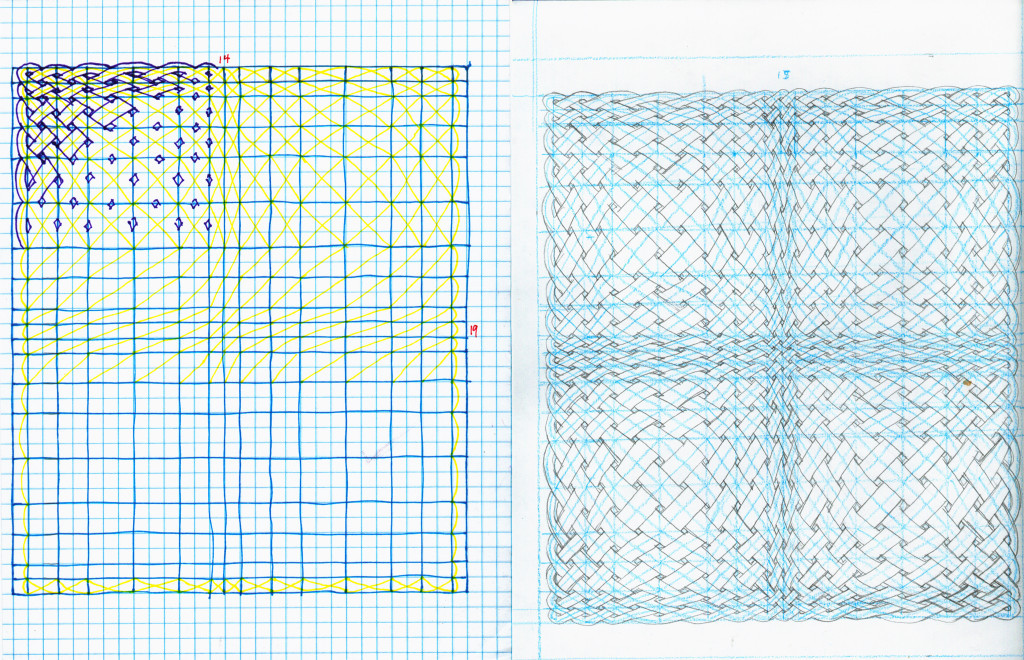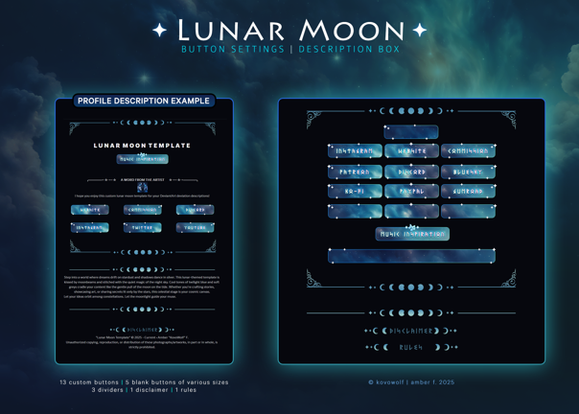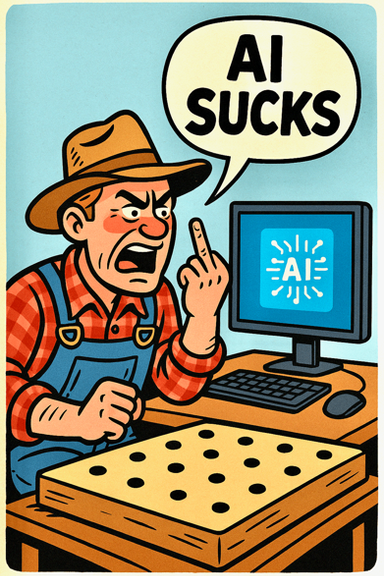HOME | DD
 1sand0s — Quad Bulge How To
1sand0s — Quad Bulge How To

Published: 2007-03-02 07:18:07 +0000 UTC; Views: 7530; Favourites: 53; Downloads: 110
Redirect to original
Description
This is how I made my Quad Bulge piece found here: [link] (and V2 here [link] This version I properly inked and shaded)There is a more detailed explanation there, but it's much easier to do with pictures. This is fairly self-explanatory, I think, for anyone who has done knot work before. The picture on the left is a quick tutorial type drawing and the right is the original sketch.On the left picture it is regular grid paper. The dark blue lines represent the new grid in order for the knot to bulge. You are able to break your lines anywhere as if you were using a normal grid. (Yes, I know some style of design uses dots, which I kind of like better, but I learned this way and it's easier for me to conceptualize.) The yellow lines represent the first incarnation of the knot. As you can see in the middle section, I only drew in one diagonal to show how each line is moving, almost like a wave, instead of the usual straight lines knot work does. Lastly, the purple represents the thickening of the ribbon, which you should know already. The tricky part here is to keep the middle squares roughly the same size. This is the main part of the illusion. If you draw them larger, the ribbon will turn out to be a uniform width. As you go along, make sure as the ribbon widens or shrinks in width, then keep the over-under lines connected.
Also note, the number of units per side. There are 15 across and 19 down. Because I chose to have the half squares vertically, the across is effectively 14, i.e. if you count the number of times the knot itself touches the top, it peaks at the points of the divisions, not the middle of the squares. Because this is 14*19, you know it will be one knot. Anytime you have a rectangular knot, as long as the width and height have no common denominators, it will be a single knot. So even numbers are tricky to do; you can only pair them with a prime number to get a single knot, i.e. 10*11 will be a single ribbon but 10*12 will not. Odd numbers are not out of the question, but even something like 3*9 would not be a single knot. So I try to stick with a prime number and then anything smaller. If P is prime, then any grid P * P-1 will be a single knot. If P= 23 then 23*22 will be a single knot. Hmm, that's not the most efficient formula. If P is prime, W is width, and H is height, then if H equals P and W is less than P, there will be one knot. If anyone cares to correct me or inform me of a condition that is untrue for, please do so. I came up with it on the spot.
The picture on the right is the original sketch done on white paper with non-photo blue pencil. It's odd how you can scan in the color, but it doesn't show up on a photo copy. Which is what I did. I photocopied this page and shrunk it by about half then colored directly on that. I should have inked the copy first, then recopied it for darker lines, but regardless, Quad Bulge turned out well.
Related content
Comments: 12

never seen this technique with a knot before, such a cool idea!
👍: 0 ⏩: 1

Thanks! It had been two years since I did this and have just gotten around to taking this technique further. For example, [link] & [link] So far I'm pleased with the results.
👍: 0 ⏩: 0

Wow, this is really cool. I've been trying my hand at knotwork. However, this gives quite a bit of fascinating and interesting information. You've inspired me to give it another shot...even though my first tries were knot so hot
...I'm sorry, I couldn't stop myself...
Really cool, though!
👍: 0 ⏩: 1

First off, thank you! And I am a sucker for corny puns so no need to apologize.
There will always be some skill you are envious of in another and they will be envious of some skill of yours. That's what I've seen in life, especially through the lens of the internet. You may not be too hot with knots but I'm not too hot with B&W drawings. I 
I like B&W because in order to get a sense of emotion you have to work twice as hard because the usual emotion detector, color, is absent. With the woman and the lamp post you hit that nail on the head. Plus, you tend not to be extravagant to get your point across; the physical equivalent of the quote, "Brevity is the soul of wit." The B&W rose is a good example.
I noticed in one or two of your comments for having to use a crappy marker. While I'm no master of the marker, I have quite a few Copics and by far some of my most favorite technical pens are by them as well. [link] For your style I would highly recommend a Brush Stroke pen because of it's flexibility plus at least one other pen to have a set line width. They do come in sets of 10 if you have the cash (60-70 bucks depending on where you buy them) but are totally worth it if you like drawing B&W. The nibs and ink are replaceable so once a marker goes dry it ends up being cheaper buying replacement ink instead of a whole new pen. Also, for the larger areas of black you could get a Copic Sketch marker, either 100 or 110, that would match the ink of the pen and save tons of time.
If that wasn't information overload and you have more questions/comments about pens or knot work just let me know!
👍: 0 ⏩: 0

Ingenious method; reminds me of some of the things M. C. Escher did with warped perspective, adding spherical distortion to his drawings; I've never seen anyone do this with a knot before.
👍: 0 ⏩: 1

Thank you. What I love about knot work is that 99.9% of knots will be unique. Beyond that, there seems to be correlations between certain styles of knots and HOW they are designed. I learned knot work using this grid method and came up with this by altering the grid. I checked your profile and see you use the dot method which tends to create more classic knots. I also saw that you were asking how ~perfalcon17x does his knot work, which is a line method. I like his because you are guaranteed a single ribbon knot but because I've not practiced much with it, it's difficult to make a more complex weaving.
Technically you can deconstruct a knot down to any given method but starting with a given method then building up, it seems to me, that each method gives a unique flavor to each knot.
Sorry, thinking out loud. Let me know if you play around with this idea; I'd love to see your rendition of this. In fact, I noticed I uploaded this 2 years ago. I need to play around with adding more curves to the middle.
👍: 0 ⏩: 2

The first method of designing knots that I learned involved the a grid, and it is what I have used most. It is also quite convenient for random doodles in notebooks, because I usually have one of those on me at work, and they come with half the grid already done for me!
Some time ago I played a lot with different types of graph paper (using a program to make custom graph paper) such as triangular, hexagonal, etc... I found that each would give a knot a totally different shape and personality, some more interesting than others. I think I have the results of one of those in the depths of my gallery somewhere... *scratches head*
👍: 0 ⏩: 0

Cool! I was going to ask for permission to make my own version of this, but I see you already gave it
I've used Bain's dot method for the last ten years, and only just learned two months ago that there is a couple other ways of making the knots. I agree with you, I think the different methods give an entirely different feel to the knots; they each have areas that they work best in, to. Meehan's method seems to work well when you have an object to turn into a knot, or an irregular space to fill with a panel, while Bain's works better IMHO for borders and regular panels. I'd never seen ~perfalcon17x's method, but those are some impressive circular panels; makes me think of Aztec or Incan artwork, really, more than Celtic.
👍: 0 ⏩: 1

Just so it doesn't take you off guard this time, I'm letting you know that I've linked to this tutorial in the comments of mine here: [link]
👍: 0 ⏩: 0






























